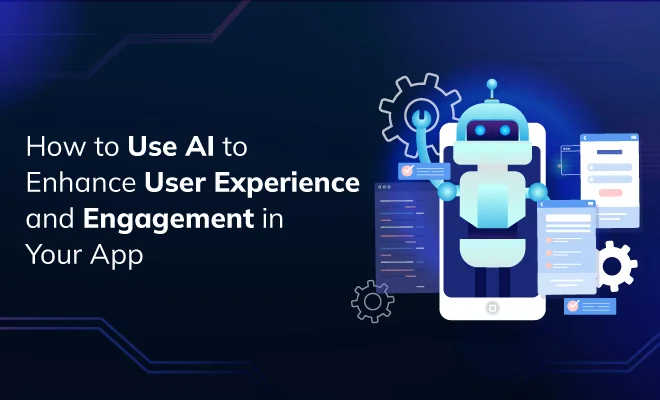How to Use AI to Enhance User Experience and Engagement in Your App
In the fast-paced app development world, fierce competition and rising user expectations make personalized UX and user engagement crucial. AI technology helps apps seamlessly adapt to users’ needs by analyzing their behavior, preferences, and feedback. This not only enhances the user experience but also leads to improved user retention and loyalty.
A renowned tech research expert Bergur Thormundsson predicts significant growth for the global AI software market in the upcoming years. He anticipated the AI software market to reach an impressive $126 billion by 2025. The shift from features to user-centric experiences has revolutionized app and software development, putting AI at the forefront.
AI Unlocks a New Era of Personalized User Experience
According to a Forbes report, 65% of consumers express continued trust in businesses and entrepreneurs utilizing AI. This emphasizes the growing acceptance of AI in enhancing user experiences and solidifying consumer-business relationships. App developers employ a range of AI techniques to personalize user experiences while developing mobile applications for diverse industries.
AI Techniques for Personalizing User Experience
Through a combination of techniques such as data mining, pattern recognition, and machine learning, AI algorithms are capable of tracing the digital footprints users leave behind. Thus, AI app development can cater to users’ preferences while also anticipating what they might want next.
Here are some techniques an app entrepreneur can utilize AI to analyze or decode user behavior to personalize user experiences:
I. Data Tracking and Analysis
AI algorithms track and analyze user interactions, such as clicks, searches, and time spent on various parts of the app. By understanding these patterns, the algorithms identify user preferences and interests.
II. Predictive Analytics
AI-empowered predictive analytics decode user behavior, uncovering patterns and preferences. This insight fuels tailored recommendations, improving user engagement.
III. User Profiling
AI-empowered automated user profiling can enable an app to segment users into different groups, like “Tech Enthusiasts,” “Fashionistas,” or “Home Decor Shoppers.” This not only helps the app to capture user behavior but also assists users to find the content of their interests and preferences.
IV. Pattern Recognition
AI algorithms use advanced pattern recognition techniques to identify trends and associations within the user’s behavior. This helps in predicting what type of content the user is likely to engage with in the future.
V. Content Analysis
AI algorithms analyze the content itself, identifying keywords, themes, and attributes. By comparing this analysis with user behaviors, the algorithms can recommend content that aligns with the user’s interests.
VI. Machine Learning Models
AI algorithms use machine learning models to continuously learn from user interactions. These models become more accurate over time, adapting to changes in user behavior and delivering increasingly relevant content recommendations.
Chatbots and Virtual Assistants for Real-time Interaction
Chatbots and virtual assistants, powered by Artificial Intelligence (AI), are changing the game in app development by offering instant engagement and assistance. Whether it’s answering queries, providing recommendations, or guiding users through complex tasks, these AI-driven tools ensure users feel connected and supported at all times.
Here is how chatbots and virtual assistants can enhance user experience:
1. AI-powered Chatbots
AI-powered chatbots are revolutionizing online user interaction. Financial institutions employ chatbots to provide personalized financial advice. E-commerce platforms utilize AI bots to offer personalized product recommendations. Many other businesses deploy AI-powered chatbots to provide immediate customer support. Requesting your app developer to implement an AI chatbot in your app can lead to improved user interactions and smooth digital experience.
2. Virtual Assistants for Improved App Experience
AI-powered virtual assistants can learn from user behaviors and interactions, adapting their responses and recommendations accordingly. A virtual assistant, for instance, in a food delivery app takes orders, suggests menu items, and tracks delivery status. Leveraging the expertise of an app development company allows for the integration of virtual assistants, resulting in better user engagement and an improved app experience.
Enhancing UI/UX Design through AI
AI ensures inclusivity, refines designs, and adapts interfaces, resulting in a more engaging and user-centric app experience. An app development company can employ AI to enhance UI/UX design by analyzing user data, predicting behaviors, and personalizing content.
Let’s examine the role of AI in empowering app developers to enrich UI/UX design, focusing on these two aspects:
1. AI Empowers Data-Informed Iterations
AI processes user interaction data to identify design inefficiencies and opportunities. App developers can then implement iterative improvements, adjusting UI/UX elements to align with user preferences, resulting in a more user-centric and intuitive app.
2. AI can Help with Predictive Design Recommendations
AI algorithms anticipate user actions and preferences by analyzing historical data. This enables proactive adjustments to the UI/UX, presenting users with relevant options, content, and navigation paths, thereby enhancing user interaction.
AI-based Voice and Image Recognition for Seamless User Interaction
Voice and image recognition, two cutting-edge features empowered by AI, have emerged as important tools in creating a seamless and engaging user experience. An app development company can leverage these capabilities to craft innovative applications that redefine user interaction.
By integrating AI-driven voice commands, users can effortlessly navigate and control apps using natural language. Voice recognition for example helps with app navigation, allowing users to ask for directions or nearby points of interest. Simultaneously, medical apps utilize image recognition to analyze medical images like X-rays, helping doctors in diagnosis.
Let’s take a look at how AI enables voice and image recognition and how these features help create a personalized app experience:
1. How AI Enables Voice Commands and Image Recognition
AI harnesses advanced algorithms for voice commands, enabling natural language understanding and seamless interaction with apps. Likewise, AI powers image recognition, allowing apps to interpret visual data, identify objects, and enhance user engagement through visual interactions.
2. How Voice Command and Image Recognition Features can Create an Engaging User Experience
By infusing AI-driven voice commands and image recognition, apps establish a more natural and engaging user experience. Users can interact intuitively through speech and visuals, fostering accessibility, convenience, and a deeper connection with the app’s functionality.
Wrap-up
In the wake of AI’s emergence and its applications worldwide, it’s reshaping our outlook on the future. AI empowers apps with diverse enhancements like personalized interactions, seamless navigation, and real-time assistance. It’s time for businesses and app entrepreneurs to seize AI’s potential to create more user-centric apps, ensuring engaging user experiences.
When seeking an AI-driven app to enhance your business, turn to Digital Innovation. As an IT services company, we harness AI to enhance user experiences. Collaborate with us for AI-empowered app development solutions that reshape your digital success and achievements.
Author



